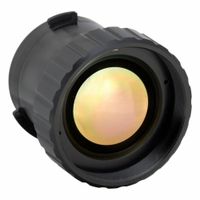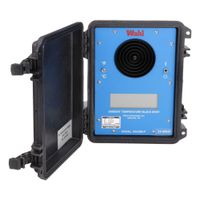Call +(254) 703 030 000 / 751 483 999 / 721 704 777
- Home
- Test Instruments
- Temperature And Environmental Measurement
- Infrared Temperature Measurement
- Infrared Thermometers Accessories
.....Read More
Frequently Asked Questions
How do infrared thermometers work?
Infrared thermometers work by detecting the infrared radiation emitted by objects. All objects emit infrared energy as a function of their temperature. The thermometer uses a lens to focus this infrared light onto a detector, typically a thermopile or a pyroelectric sensor. The detector absorbs the infrared radiation and converts it into an electrical signal.
The intensity of the infrared radiation is directly related to the temperature of the object. The thermometer's internal electronics then process this signal, using algorithms to convert it into a temperature reading, which is displayed on the device.
Infrared thermometers are non-contact devices, meaning they can measure temperature from a distance without touching the object. This is particularly useful for measuring the temperature of moving objects, hazardous materials, or surfaces that are difficult to reach.
The accuracy of an infrared thermometer can be affected by several factors, including the emissivity of the object's surface, ambient temperature, and distance from the object. Emissivity is a measure of how efficiently an object emits infrared radiation and can vary between different materials. Many infrared thermometers allow users to adjust the emissivity setting to improve accuracy for different surfaces.
Infrared thermometers are widely used in various fields, including medical, industrial, and food safety applications, due to their speed, convenience, and ability to measure temperature without direct contact.
What is the accuracy of infrared thermometers?
The accuracy of infrared thermometers typically ranges from ±0.5°C to ±2°C (±0.9°F to ±3.6°F), depending on the quality and design of the device. High-quality medical-grade infrared thermometers, often used in clinical settings, tend to have higher accuracy, usually around ±0.5°C (±0.9°F). In contrast, consumer-grade models might have a broader accuracy range, often around ±1°C to ±2°C (±1.8°F to ±3.6°F).
Several factors can influence the accuracy of infrared thermometers:
1. **Emissivity**: Infrared thermometers measure the thermal radiation emitted by an object. The emissivity of the object's surface can affect readings. Most thermometers are calibrated for an emissivity of 0.95, which is typical for human skin, but variations can lead to inaccuracies.
2. **Distance-to-Spot Ratio**: This ratio determines the area measured by the thermometer. A higher ratio allows for more precise targeting of smaller areas from a distance. If the thermometer is too far from the target, it may include surrounding temperatures, affecting accuracy.
3. **Environmental Conditions**: Ambient temperature, humidity, and airflow can impact readings. Rapid changes in environmental conditions can lead to less accurate measurements.
4. **Calibration**: Regular calibration is essential for maintaining accuracy. Over time, sensors can drift, necessitating recalibration to ensure precise readings.
5. **Surface Characteristics**: The texture and color of the surface being measured can also affect accuracy. Shiny or reflective surfaces may require adjustments or the use of a contact thermometer for comparison.
In summary, while infrared thermometers offer a convenient and non-contact method for temperature measurement, their accuracy can vary based on several factors. Proper usage, regular calibration, and understanding the limitations of the device are crucial for obtaining reliable readings.
How do you calibrate an infrared thermometer?
1. **Preparation**: Ensure the infrared thermometer and the calibration source are at the same ambient temperature. Allow the thermometer to acclimate to the environment for at least 30 minutes.
2. **Select Calibration Source**: Use a blackbody calibration source, which is a device that emits a known and stable temperature. Alternatively, use a surface with a known emissivity and temperature, such as a water bath or a solid surface with a temperature probe.
3. **Set Emissivity**: Adjust the infrared thermometer’s emissivity setting to match the emissivity of the calibration source. Most blackbody sources have an emissivity close to 1.0.
4. **Measure Calibration Source**: Aim the infrared thermometer at the calibration source. Ensure the thermometer’s field of view is fully covered by the source to avoid errors from surrounding temperatures.
5. **Take Readings**: Record the temperature displayed by the infrared thermometer. Take multiple readings to ensure consistency.
6. **Compare and Adjust**: Compare the thermometer’s readings with the known temperature of the calibration source. If there is a discrepancy, adjust the thermometer’s settings if possible, or note the deviation for future reference.
7. **Document Results**: Record the calibration results, including the date, ambient conditions, calibration source details, and any adjustments made.
8. **Repeat Regularly**: Calibrate the infrared thermometer regularly, especially if it is used frequently or in critical applications, to ensure ongoing accuracy.
What are the best infrared thermometer accessories?
1. **Protective Case**: A durable case protects the infrared thermometer from physical damage, dust, and moisture, ensuring longevity and reliability.
2. **Calibration Tools**: Regular calibration is essential for maintaining accuracy. Calibration tools or services help ensure the thermometer provides precise readings.
3. **Tripod Mount**: A tripod mount allows for stable, hands-free operation, which is particularly useful for continuous monitoring or when precise positioning is required.
4. **Laser Sights**: Some infrared thermometers come with laser sights to help accurately target the area being measured, especially useful in industrial settings.
5. **Extension Probes**: For thermometers that support them, extension probes can measure temperatures in hard-to-reach areas or surfaces that are not directly visible.
6. **Software and Connectivity Cables**: For models with data logging capabilities, software and connectivity cables (USB or Bluetooth) allow for data transfer to computers or mobile devices for analysis and record-keeping.
7. **Batteries and Chargers**: Spare batteries and chargers ensure the thermometer is always ready for use, especially in fieldwork or remote locations.
8. **Lens Cleaning Kit**: A lens cleaning kit helps maintain the optical components of the thermometer, ensuring accurate readings by preventing dust and smudges from interfering with measurements.
9. **Carrying Strap**: A carrying strap or lanyard provides convenience and reduces the risk of dropping the device during use.
10. **Instruction Manual**: A comprehensive manual or guide can be an invaluable resource for troubleshooting and maximizing the use of the thermometer’s features.
These accessories enhance the functionality, accuracy, and convenience of infrared thermometers, making them more versatile and reliable for various applications.
Can infrared thermometers measure body temperature?
Yes, infrared thermometers can measure body temperature. They work by detecting the infrared radiation emitted by the body. When pointed at the forehead or other body parts, they capture the emitted infrared energy and convert it into an electrical signal, which is then displayed as a temperature reading. These thermometers are non-contact, making them convenient for quick screenings and reducing the risk of cross-contamination. However, their accuracy can be influenced by factors such as distance from the skin, ambient temperature, and the presence of sweat or dirt on the skin. Proper calibration and usage according to the manufacturer's instructions are essential for obtaining reliable readings.
How do you maintain an infrared thermometer?
To maintain an infrared thermometer, follow these steps:
1. **Regular Cleaning**: Use a soft, damp cloth to clean the exterior. For the lens, use a cotton swab or lens tissue with a gentle lens cleaner. Avoid using abrasive materials or solvents.
2. **Proper Storage**: Store the thermometer in a protective case to prevent dust accumulation and physical damage. Keep it in a cool, dry place away from direct sunlight and extreme temperatures.
3. **Battery Maintenance**: Regularly check and replace the batteries to ensure optimal performance. Remove batteries if the device will not be used for an extended period to prevent leakage.
4. **Calibration**: Periodically calibrate the thermometer according to the manufacturer's instructions or have it professionally calibrated to maintain accuracy.
5. **Avoid Dropping**: Handle the thermometer with care to prevent damage from drops or impacts, which can affect its accuracy and functionality.
6. **Environmental Considerations**: Use the thermometer in environments within the specified temperature and humidity range to ensure accurate readings.
7. **Check for Damage**: Regularly inspect the thermometer for any signs of physical damage or wear, such as cracks or loose parts, and address any issues promptly.
8. **Firmware Updates**: If applicable, update the device's firmware to the latest version to benefit from improvements and bug fixes.
9. **Follow Manufacturer Guidelines**: Adhere to the specific maintenance and usage guidelines provided by the manufacturer to ensure the longevity and reliability of the device.
By following these steps, you can ensure that your infrared thermometer remains accurate and reliable over time.
What factors affect the accuracy of infrared thermometers?
Factors affecting the accuracy of infrared thermometers include:
1. **Emissivity**: Different materials emit infrared radiation differently. If the emissivity setting on the thermometer does not match the object's emissivity, it can lead to inaccurate readings.
2. **Distance-to-Spot Ratio**: This ratio determines the area measured by the thermometer. A larger distance increases the measured area, potentially including unwanted surfaces, affecting accuracy.
3. **Ambient Temperature**: Extreme ambient temperatures can affect the thermometer's sensor, leading to errors. Proper calibration is necessary to account for these conditions.
4. **Reflective Surfaces**: Shiny or reflective surfaces can reflect infrared radiation from other sources, leading to incorrect temperature readings.
5. **Obstructions**: Dust, smoke, or steam between the thermometer and the target can interfere with the infrared radiation, affecting accuracy.
6. **Calibration**: Regular calibration against a known temperature standard is essential to maintain accuracy over time.
7. **Target Size**: The target should be larger than the thermometer's field of view. If the target is too small, the thermometer may include background temperatures in its reading.
8. **Environmental Conditions**: Factors like humidity, wind, and rapid temperature changes can impact the thermometer's performance.
9. **Battery Life**: Low battery can affect the device's functionality, leading to inaccurate readings.
10. **User Error**: Incorrect usage, such as improper aiming or not allowing the device to acclimate to the environment, can result in errors.
11. **Device Quality**: The build quality and sensor precision of the thermometer can significantly influence its accuracy.
12. **Surface Temperature Variability**: Non-uniform surface temperatures can lead to inconsistent readings if the thermometer is not aimed at the hottest or most relevant part of the surface.


